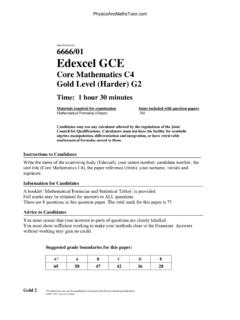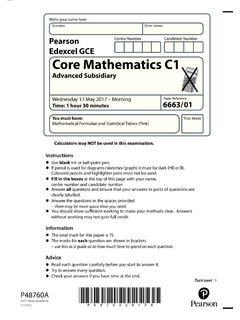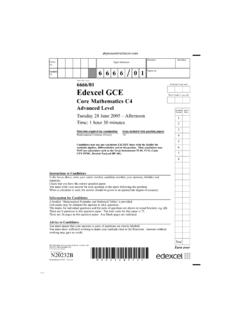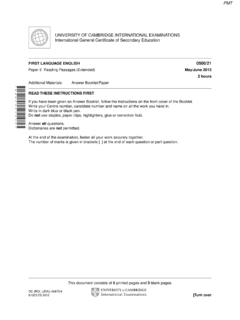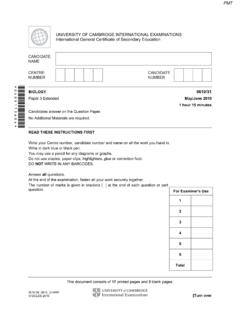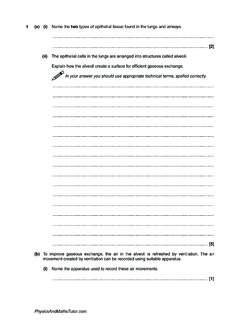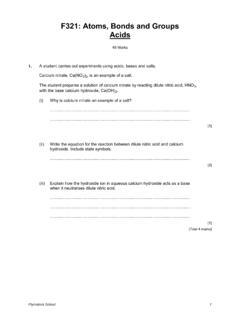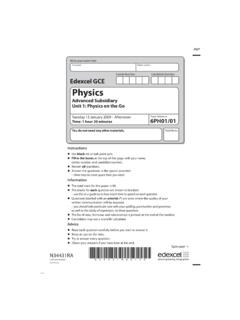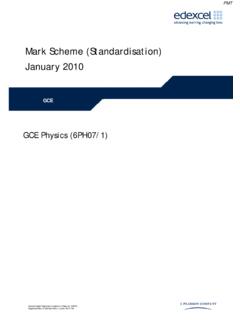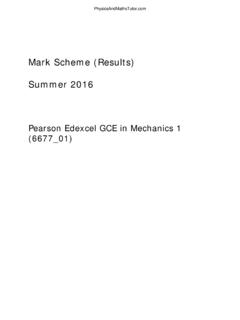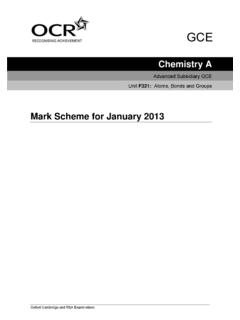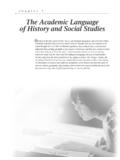Transcription of Advanced Subsidiary GCE Unit F212: Molecules, …
1 Oxford Cambridge and RSA Examinations GCEB iology Advanced Subsidiary GCE unit f212 : molecules , biodiversity , food and health Mark Scheme for January 2011 PMT OCR (Oxford Cambridge and RSA) is a leading UK awarding body, providing a wide range of qualifications to meet the needs of pupils of all ages and abilities. OCR qualifications include AS/A Levels, Diplomas, GCSEs, OCR Nationals, Functional Skills, Key Skills, Entry Level qualifications, NVQs and vocational qualifications in areas such as IT, business, languages, teaching/training, administration and secretarial skills. It is also responsible for developing new specifications to meet national requirements and the needs of students and teachers. OCR is a not-for-profit organisation; any surplus made is invested back into the establishment to help towards the development of qualifications and support which keep pace with the changing needs of today s society.
2 This mark scheme is published as an aid to teachers and students, to indicate the requirements of the examination. It shows the basis on which marks were awarded by Examiners. It does not indicate the details of the discussions which took place at an Examiners meeting before marking commenced. All Examiners are instructed that alternative correct answers and unexpected approaches in candidates scripts must be given marks that fairly reflect the relevant knowledge and skills demonstrated. Mark schemes should be read in conjunction with the published question papers and the Report on the Examination. OCR will not enter into any discussion or correspondence in connection with this mark scheme. OCR 2011 Any enquiries about publications should be addressed to: OCR Publications PO Box 5050 Annesley NOTTINGHAM NG15 0DL Telephone: 0870 770 6622 Facsimile: 01223 552610 E-mail: PMTF212 Mark Scheme January 2011 Question Expected Answer Mark Additional Guidance 1 (a) (i) human immunodeficiency virus / HIV ; 1 DO NOT CREDIT if there is any ref to AIDS 1 (a) (ii) 12 3 (infective agent), in blood / body fluids ; idea of: used needles are contaminated ; ora reduces chance of sharing needles.
3 Ora 2 max 1 ACCEPT any infective agent even if incorrect as question asks for mode of transmission 2 ACCEPT used needles are infected 2 ACCEPT new needles are sterile 2 DO NOT CREDIT dirty / clean needles 3 IGNORE prevents / stops 1 (b) (i) amino acid(s) ; nucleotide(s) ; 2 Answers must be on correct line ACCEPT phonetic spelling for both DO NOT CREDIT if ref to DNA / nucleosides ACCEPT ribonucleotides 1 (b) (ii) 1234 reverse transcriptase in (host) nucleus ; viral DNA, (inserted) in (host), chromosome / DNA ; idea of: (viral) RNA / mRNA produced / transcribed ; (to) code for / make / translate, viral proteins ; 2 max 4 IGNORE different protein 1 PMTF212 Mark Scheme January 2011 Question Expected Answer Mark Additional Guidance 1 (c) (i) 123456789 not vaccinated against TB ; weakened immune system ; (lifestyle) poor diet / lack of protein / malnourished / smoking / alcoholism ; homelessness ; poor ventilation (of housing) / AW ; overcrowding ; close contact with people from / visiting, area where TB is common ; close / prolonged, contact with individual(s) with TB ; consumption of milk or beef, from infected cattle / in developing countries.
4 3 max Mark the first three answers only regardless of which line they are on 1 IGNORE general refs to lack of medical care 3 DO NOT CREDIT alcohol unqualified IGNORE poor health 7 ACCEPT area where those with TB are not quarantined 2 PMTF212 Mark Scheme January 2011 Question Expected Answer Mark Additional Guidance (c) (ii) 12345 cytokine / interleukin / receptor has, specific / unique, shape ; (cytokine / interleukin), binds / attaches / bonds to / fits into, receptor ; receptor on (cell surface) membrane (of B lymphocyte) ; (receptor and cytokine have) complementary shapes ; activates / stimulates, clonal expansion / mitosis ; 3 max 1 DO NOT CREDIT cytokine is specific to receptor as this is implied in question 3 DO NOT CREDIT antibodies (on cell surface) 5 ACCEPT activates / releases 2nd messenger Total13 3 PMTF212 Mark Scheme January 2011 Question Expected Answer Mark Additional Guidance 2 (a) (i) blue-black / black / dark blue ; 1 ACCEPT dark purple / purplish-blue DO NOT CREDIT blue or purple unqualified by darkness ACCEPT acceptable colour change 2 (a) (ii) 12 between oxygen and hydrogen (atoms) ; (between) electronegative / -, and electropositive / +.
5 2 CREDIT marking points from clearly labelled diagram max 1 if incorrect charges are on atoms 1 DO NOT CREDIT molecules / ions 2 DO NOT CREDIT ions / + and 2 ACCEPT slight / partial (negative / positive), charge 2 (a) (iii) 123 hydrogen / H, bonds break ; helix, lost / unravels / AW ; iodine, released / no longer in complex / AW ; 2 max IGNORE refs to denaturation 2 ACCEPT spiral / coil 3 ACCEPT no longer contained in helix 4 PMTF212 Mark Scheme January 2011 Question Expected Answer Mark Additional Guidance take samples at a range of times / AW ; same volumes (of solutions) added / removed (each time) ; heat with, Benedict s (solution) / CuSO4 and NaOH ; (use of ) excess Benedict s ; changes to, green / yellow / orange / brown / (brick) red ; remove precipitate / obtain filtrate ; colorimeter ; calibrate / zero, using, a blank / water / (unreacted) Benedict s ; use (red / orange) filter ; reading of, transmission / absorbance OR mass of precipitate ; more transmission / less absorbance, of filtrate, OR greater mass ppt, = more maltose present ; ora using, standard / known, concentrations (of maltose) ; (obtain) calibration curve ; plot, transmission / absorbance / mass of ppt, against (reducing sugar) concentration ; use graph to read off concentration of maltose / AW.
6 6 max B2 must be in context of Benedict s test rather than reaction mixture B3 DO NOT CREDIT boil / warm B3 DO NOT CREDIT if Benedict s added to the mixture at the beginning C6 CREDIT description of method filtering / centrifuging / decanting 8 IGNORE control 9 DO NOT CREDIT if colour of filter is incorrect T10 ACCEPT measure how much light, does / does not, pass through 11 if unfiltered Benedict s / precipitate is clearly indicated as being present in sample, ACCEPT less transmission / more absorbance, = more maltose present 11 DO NOT CREDIT if precipitate is added to colorimeter 12 CREDIT serial dilutions 2 (b) 1B2B3 B4B5C6C789T10 11 12131415 QWC correct sequence ; 1 1 of mps B2 to B5, then mp C6 or C7, then mp T10 5 PMTF212 Mark Scheme January 2011 Question Expected Answer Mark Additional Guidance 2 (c) (i) 123 increases / greater / faster ; reaction completed in / plateaus after / concentration is 100% after, minutes ;figures with units to support mp 1 ; 2 max 1 ACCEPT any time between and min.
7 3 two maltose concentrations (+ or chloride) for a given time or two times (+ or chloride) for given maltose concentration. 3 ACCEPT calculated difference 3 DO NOT CREDIT if % and min. not given 3 ACCEPT any concentration within 1 % and time within min. The percentage concentration of maltose (%) present every half a minute Presence or absence of chloride ions min min min min min min min min min Chloride ions present 0 24 54 70 80 88 95 100 100 Chloride ions absent 0 12 20 29 36 40 45 48 50 Difference in maltose concentration When chloride ions are either present or absent 0 12 34 41 44 48 50 52 50 Allow a + /- 1% for any concentration of maltose and a +/- 2% for the difference in maltose concentrations 2 (c) (ii) 123 (acts as a) cofactor ; (Cl-) binds to, enzyme / amylase / amylose / substrate ; enzyme substrate complex / ESC, forms more, easily / quickly.
8 2 max 1 IGNORE coenzyme 2 ACCEPT binds to, active site 3 ACCEPT description 6 PMTF212 Mark Scheme January 2011 Question Expected Answer Mark Additional Guidance 2 (c) (iii) 123456 temperature ; pH ; enzyme / amylase / chloride, concentration ; substrate / starch / amylose, concentration ; constant / regular, stirring ; (fixed) volume of solution (removed each time for sampling) ; 3 max Mark the first three answers only regardless of which line they are on DO NOT CREDIT refs to, time 3 IGNORE amount or volume 3 DO NOT CREDIT concentration unqualified 4 IGNORE amount or volume 4 DO NOT CREDIT concentration unqualified Total19 7 PMTF212 Mark Scheme January 2011 Question Expected Answer Mark Additional Guidance 3 (a) (i) 1234 (all), sub-arctic / all 4 named sub-arctic, species / birds, show decrease ; (all / most), other / non sub-arctic / all 4 named non sub-arctic, species / birds, show, increase / no change ; greater change / AW (in breeding success), in sub-arctic than in non sub-arctic species ; comparative figs (in 1970 AND 2000).
9 3 ACCEPT reference to numbers rather than breeding success throughout 1 sub-arctic species = snow bunting + Lapland bunting + ptarmigan + dotterel 2 non sub-arctic species = red grouse + wheatear + meadow pipit + ring ouzel 4 number of young for one sub-arctic and one non sub-arctic species in 1970 and 2000 (or calculated subtraction between the two years) 4 DO NOT CREDIT if figures are not from 1970 and 2000 number of young raised per year species 1970 2000 difference in number of young raised between 1970 and 2000 Snow bunting* 78 2 Down 76 Lapland bunting* 7 0 Down 7 Ptarmigan* 1280 876 Down 404 Red grouse 890 962 Up 72 Wheatear 209 231 Up 22 Meadow pipit 23 82 Up 59 Ring ouzel 23 26 Up
10 3 Dotterel* 45 35 Down 10 8 PMTF212 Mark Scheme January 2011 Question Expected Answer Mark Additional Guidance 3 (a) (ii) 12345 climate change / global warming ; (environmental) change too rapid for adaptation ; change in, flora / plants / food supply / insects / prey / predators / human activity ; disease (that affects sub-arctic species more than others) ; sub-arctic species, less well-adapted than / have been outcompeted by, non sub-arctic species / AW ; 2 max 1 IGNORE greenhouse effect 1 DO NOT CREDIT it is too warm or it is not cold enough without reference since 1970 3 ACCEPT camouflage no longer appropriate / reduction in size of habitats 5 ACCEPT ora 3 (b) (i) the number of species present (in a habitat) ; 1 DO NOT CREDIT range / amount 9 PMTF212 Mark Scheme January 2011 Question Expected Answer Mark Additional Guidance 3 (b) (ii) 123456 idea of: unbiased method to selecting sampling area ; sample many times / AW, and calculate mean / aver
